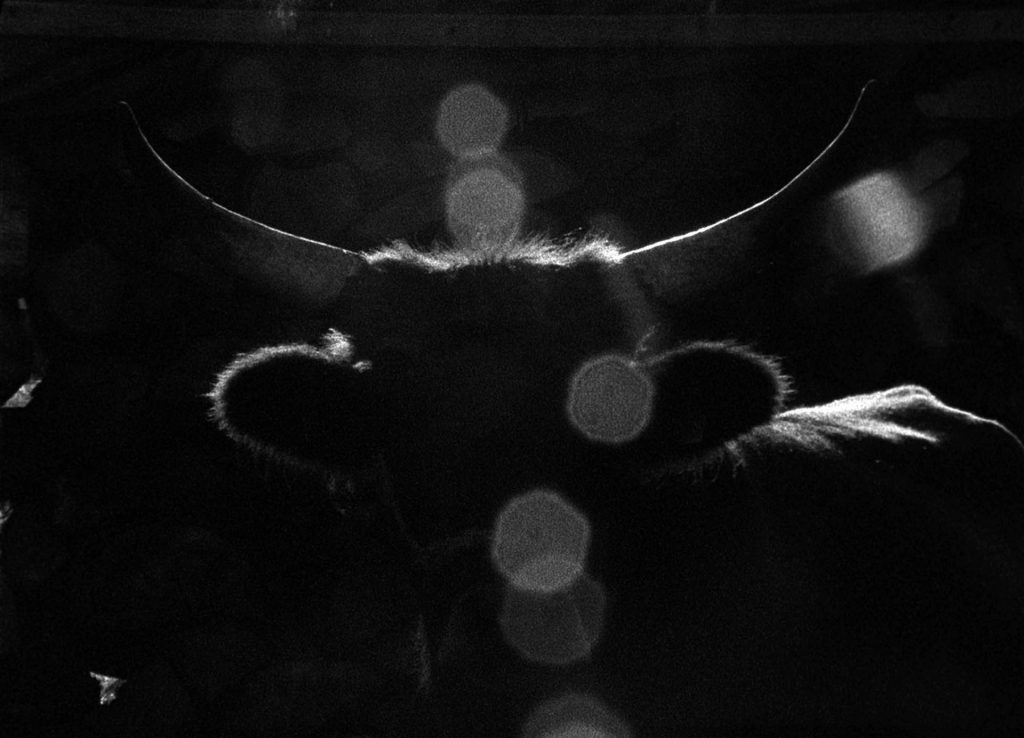
Christopher M. Cabrera
The last of the aurochs, a type of bovine considered an ancestor to modern cattle, went extinct centuries ago, but interest in the animal has hardly waned. In their latest film, Her Name Was Europa (a reference to the goddess of the same name in Greek myth who was tricked into riding an aurochs which was actually Zeus in disguise), Berlin-based filmmakers Anja Dornieden and Juan David González Monroy (who collectively go by OJOBOCA) seek out recent efforts by scientists, geneticists, and enthusiasts to revive the animal, which once roamed the forests and plains of Europe. But theirs is no ordinary nature film, as the aurochs is not your typical animal. Much of what we know about the aurochs is steeped in mystery, and the directors choose a visual and narrative style that diverges from typical nature documentaries. It becomes clear throughout the film just how much of what we know about the aurochs stems from pure guesswork. What we see is the extent of mankind’s interventions in the revival and reimagining of a species as well as the ideological motives behind them.
The film begins by introducing the last successful breeding of an aurochs-like bovine by Lutz Heck, a scientist working for the Nazi regime. It becomes apparent that the revival of the lost breed was only part of a larger nationalist project that saw the aurochs as part of a romanticized past, a national identity. His crossbred specimens were wiped out during the final years of WWII, but efforts have been made by numerous organization to revive the aurochs and bring the breed—or at least something close to the breed—back to life again to repopulate the forests and plains of Europe. Are these modern projects linked to a similar motivation? The filmmakers do not explicitly say, but they do call attention to how we might begin to think of what lies behind modern aurochs research. Is it simply science, an effort to restore nature, or are the motivations behind research into the natural world tinged with something more?
With no real visual evidence of the species, the film focuses in on how much of the project involves questions about the breed’s appearance. Experts can only hypothesize and debate over what it may have looked like, and many disagree with each other. Decisions about the appearance affect how geneticists approach the project as well. We see many models of the aurochs throughout the film, all differing slightly, made in the image of their creators. The filmmakers pay close attention to these images, framing these recreations as we hear informative conversations in the background: a compact 3-D printed model, a sketch by an illustrator and specialist, and finally, a massive aurochs sculpture crafted to scale by an expert sculptor. The latter is the largest and most ambitious project, which we see assembled from the base up and headless at one point as it is assembled before our eyes. The massive aurochs statue is then seen being hoisted out of a truck and set in the forest, ironically juxtaposing this fake creature with the backdrop of a natural world. We will probably never know if this fierce, towering bull is indeed the aurochs, or if the creature was more like the compact, nondescript cattle the illustrator suggests.
Aside from its focus on the constructed image of the aurochs, Her Name is Europa is also a self-reflexive exercise in the constructed nature of cinema itself. Shot with 16mm black-and-white film stock, the directors do not hide the cinematic artifice from the viewer, revealing the assembled nature of a film at many junctures. Instead of digitally inserted text, a pair of hands are seen at the sides of the frame sliding sheets of text in front of the camera that serve as intertitles. The materiality of the film stock itself is made candid when the film alerts us to a mishap in some footage taken at a genetics lab which had been soiled and ruined during transport. This is filmed a second time, on different film stock, and we are shown what remains of the soiled original take before being shown the new footage. The directors note how the lab staff were kind enough to “reenact” their procedures—what we are seeing is, of course, never “the real thing”—for the camera just as they had done before. In breaking with cinematic immersion and reminding viewers of the fourth wall, the film seems to address the typical nature documentary’s claims to knowledge that are embedded in the cinematic form. This acceptance of film’s materiality reinforces the idea that its subject, the aurochs, is also a synthetic construct. In reminding us of the fragility and artifice of film, we also question everything we are told about the aurochs, destabilizing our understanding of the complex creature.
Then there is the ending of the film, where it is revealed that the fictional sequence planned for the finale will not go ahead as planned. Instead, we see shots of the directors lounging on the bizarre locale selected for the axed final scenes: a bizarre indoor tropical resort that was constructed out of a scrapped military project. This plastic South Seas experience, we are reminded, is a hollow cash grab. In this large dome-like structure foreign investors play god by building a tropical paradise much like how in laboratories they recreate extinct creatures.
The final shots of the revived aurochs breed make for a bizarre end to the labyrinth of questions and debates posed about the creature. The creature of so much mystery is finally revealed: living, breathing, eating, and watching the camera, watching us. There is no subsequent finale, no further reveal, because seeing these creatures in the flesh, without the baggage of mankind’s intervention, is perhaps the only way to end a film that has said so much about artificiality.
![ドキュ山ライブ! [DOCU-YAMA LIVE!]](http://www.yidff-live.info/wp-content/themes/yidff-live_2017/images/header_sp_logo1.png)

